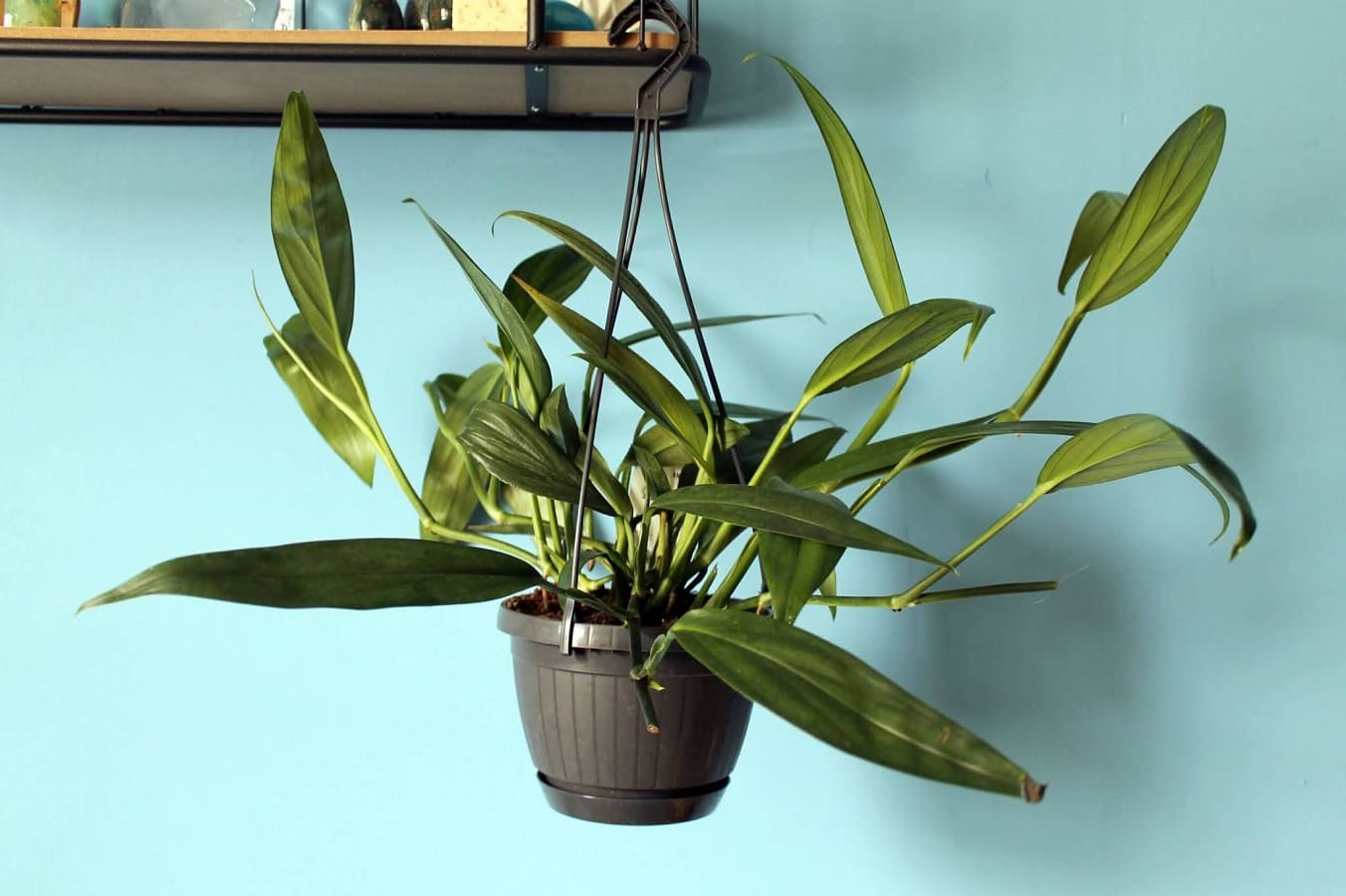Have you ever walked into a plant shop and been stopped dead in your tracks by a plant that looks like it was hand-painted by nature herself? That’s exactly what happened to me the first time I encountered an Epipremnum amplissimum.
Those distinctive silver streaks dancing across elongated green leaves seemed almost too beautiful to be real—like someone had taken a fine brush and carefully added metallic accents to each leaf.
While most people are familiar with the classic Golden Pothos, this stunning cousin has been quietly winning hearts in the houseplant community.
Sometimes called Silver Streak Pothos or even mistaken for Rhaphidophora amplissima, this plant brings an elegant sophistication that’s hard to match. If you’re ready to elevate your plant game with something truly special, you’re in for a treat.
What Makes Epipremnum Amplissimum So Special?
The Story Behind the Silver Streaks
Epipremnum amplissimum hails from the tropical rainforests of Southeast Asia, particularly the Bismarck Archipelago, Papua New Guinea, and surrounding Pacific islands. In its native habitat, this climbing vine scrambles up tree trunks in lowland rainforests, reaching toward filtered sunlight through the forest canopy.
The name itself tells a story: “Epipremnum” roughly translates to “upon the stem,” referring to its climbing nature, while “amplissimum” means “most abundant” or “very large,” hinting at its potential size. In the wild, these vines can reach impressive proportions, with stems up to 3 cm in diameter and leaves stretching over 2 feet long.
What sets this plant apart from its more common relatives isn’t just those gorgeous silver markings—it’s the plant’s entire personality. Unlike other Epipremnum varieties that develop fenestrations (splits) as they mature, the Silver Streak maintains its elegant, lance-shaped leaves throughout its life, though they do become broader and longer with age.
Understanding the Varieties
Not all Epipremnum amplissimum plants look identical. There are several forms you might encounter:
- Standard Green Form:
The most common variety features solid green leaves without variegation. While lacking the silver streaks, it’s often more affordable and equally easy to care for.

- Silver Streak (Most Popular):
This is the variety that’s captured everyone’s attention, with those distinctive bluish-green leaves marked by silvery, metallic stripes that seem to shimmer in the light.
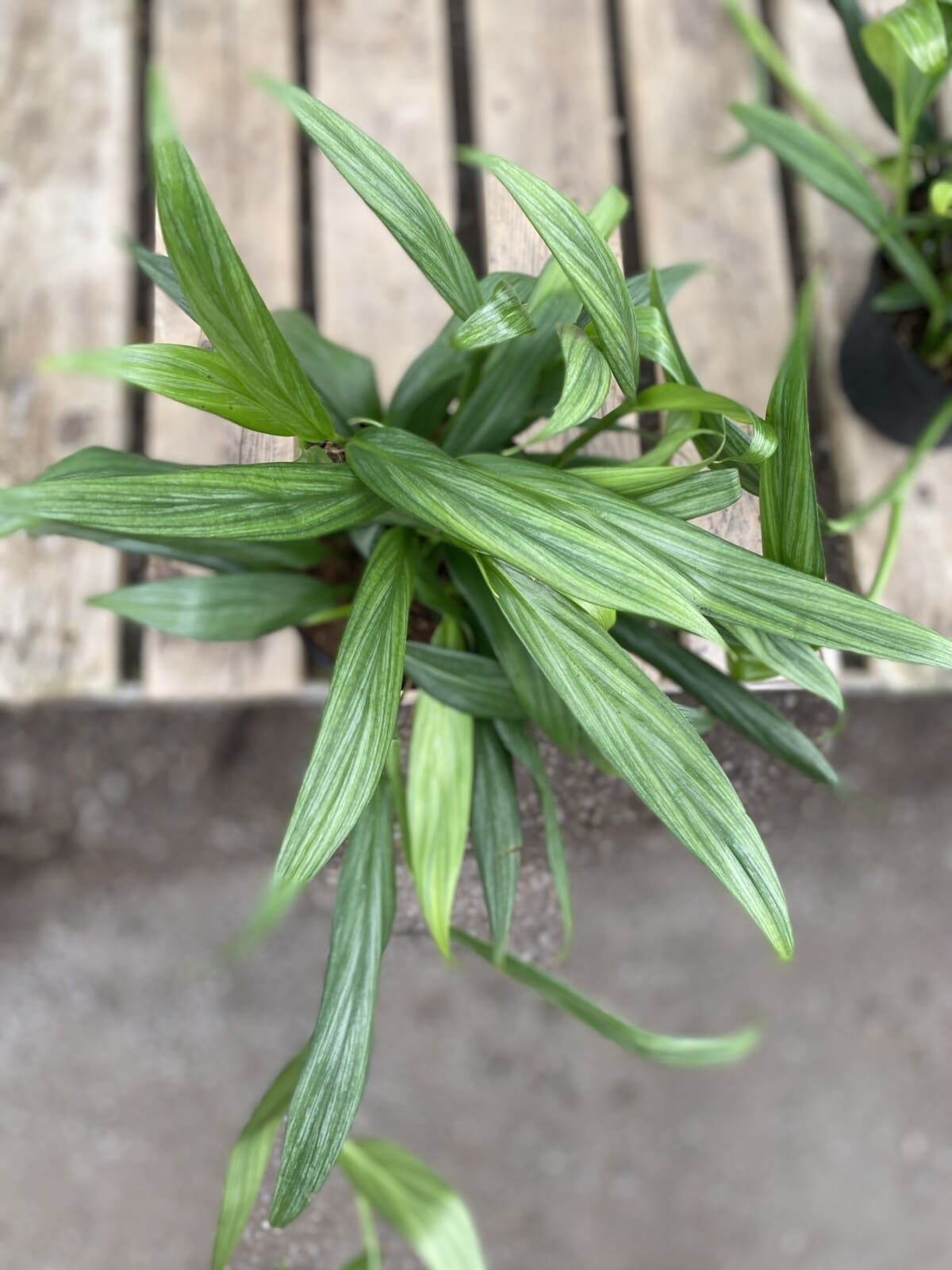
- Aurea Variegated:
A rarer form featuring patches of yellow or cream variegation mixed with green. This variety requires slightly brighter light to maintain its coloration.
The silver markings are most prominent when plants are young and gradually fade as they mature, though some plants retain traces of their juvenile coloration even when fully grown.
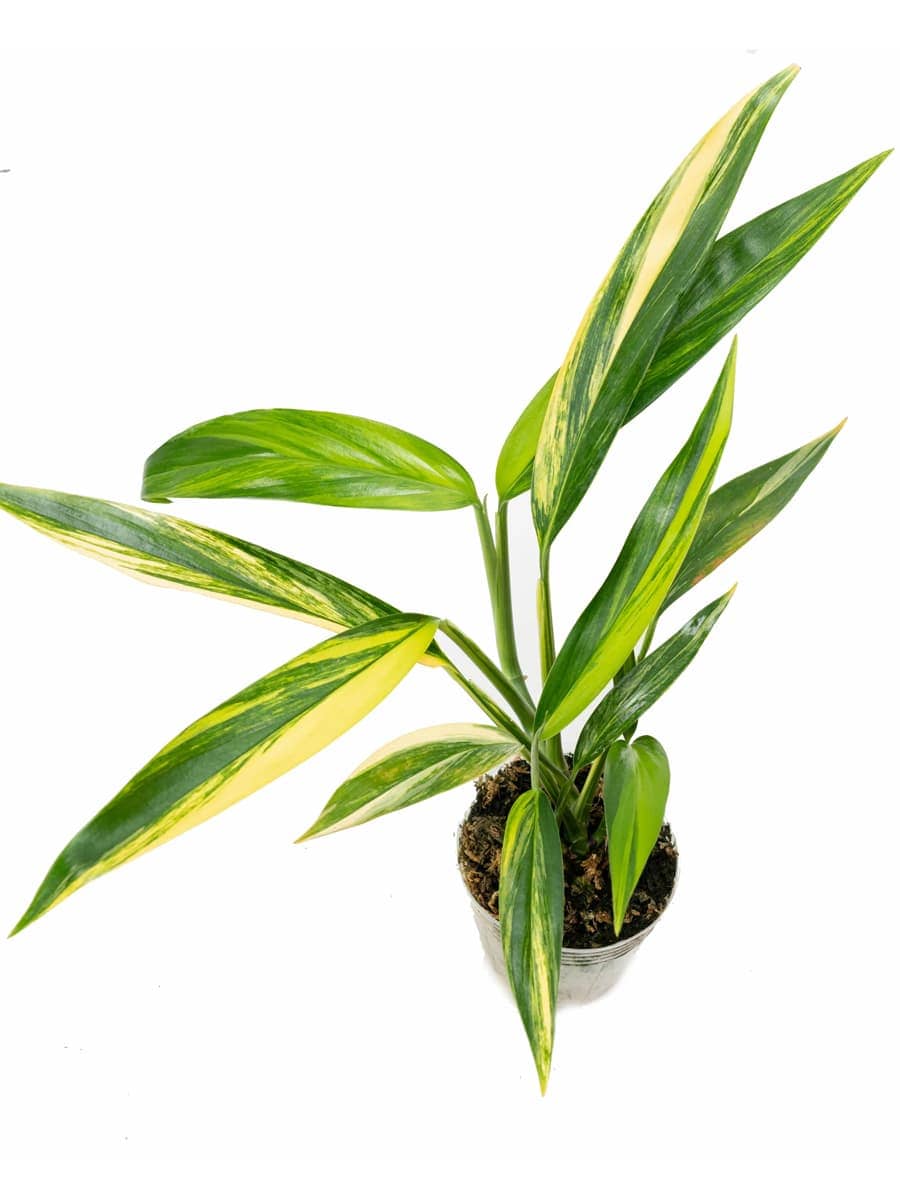
Pronunciation Made Simple
Before we dive deeper, let’s tackle the elephant in the room: how do you actually say “Epipremnum amplissimum”? Break it down as: eh-pih-PREM-num am-PLIS-ih-mum. Don’t worry if it takes a few tries—most of us just call it Silver Streak Pothos anyway!
Understanding Your Silver Streak’s Needs
Light: Finding the Sweet Spot
Think of your Silver Streak as a forest dweller who’s used to dappled sunlight filtering through tree branches. This translates to bright, indirect light in your home—not the harsh glare of a south-facing window, but not the dim corner where you’ve been banishing your less photogenic plants either.
The ideal setup provides 4-6 hours of bright, indirect light daily. I’ve found the perfect spot for mine is about six feet from a large east-facing window, where it receives gentle morning light but stays protected from intense afternoon sun. West-facing windows can work too, but position the plant a few feet back or use a sheer curtain to filter the light.
Signs your lighting is just right:
- Silver streaks remain vibrant and defined
- New growth appears regularly during growing season
- Leaves maintain their characteristic blue-green color
- No brown, crispy edges on leaf tips
Too much light symptoms:
- Brown, scorched patches on leaves
- Fading or bleaching of the green color
- Leaves curling inward to protect themselves
Too little light indicators:
- Silver markings become less pronounced
- Long, spindly growth with large gaps between leaves
- Slower growth overall
- Leaves may become darker green
Watering: Reading Your Plant’s Thirst Cues
Here’s where many plant parents go wrong: they treat their Silver Streak like a thirsty toddler, constantly offering water “just in case.” This plant actually prefers a more measured approach to hydration.
The golden rule is to water when the top inch or two of soil feels dry to the touch, but the plant shouldn’t completely dry out. Unlike some succulents that prefer to go bone dry, your Silver Streak likes consistent moisture without being waterlogged.
I learned this lesson the hard way when I first brought my Silver Streak home. Eager to be the perfect plant parent, I watered it religiously every week, regardless of what the soil felt like.
Within a month, I noticed the lower leaves turning yellow—a classic sign of overwatering. After adjusting my approach and actually feeling the soil before watering, the plant bounced back beautifully.
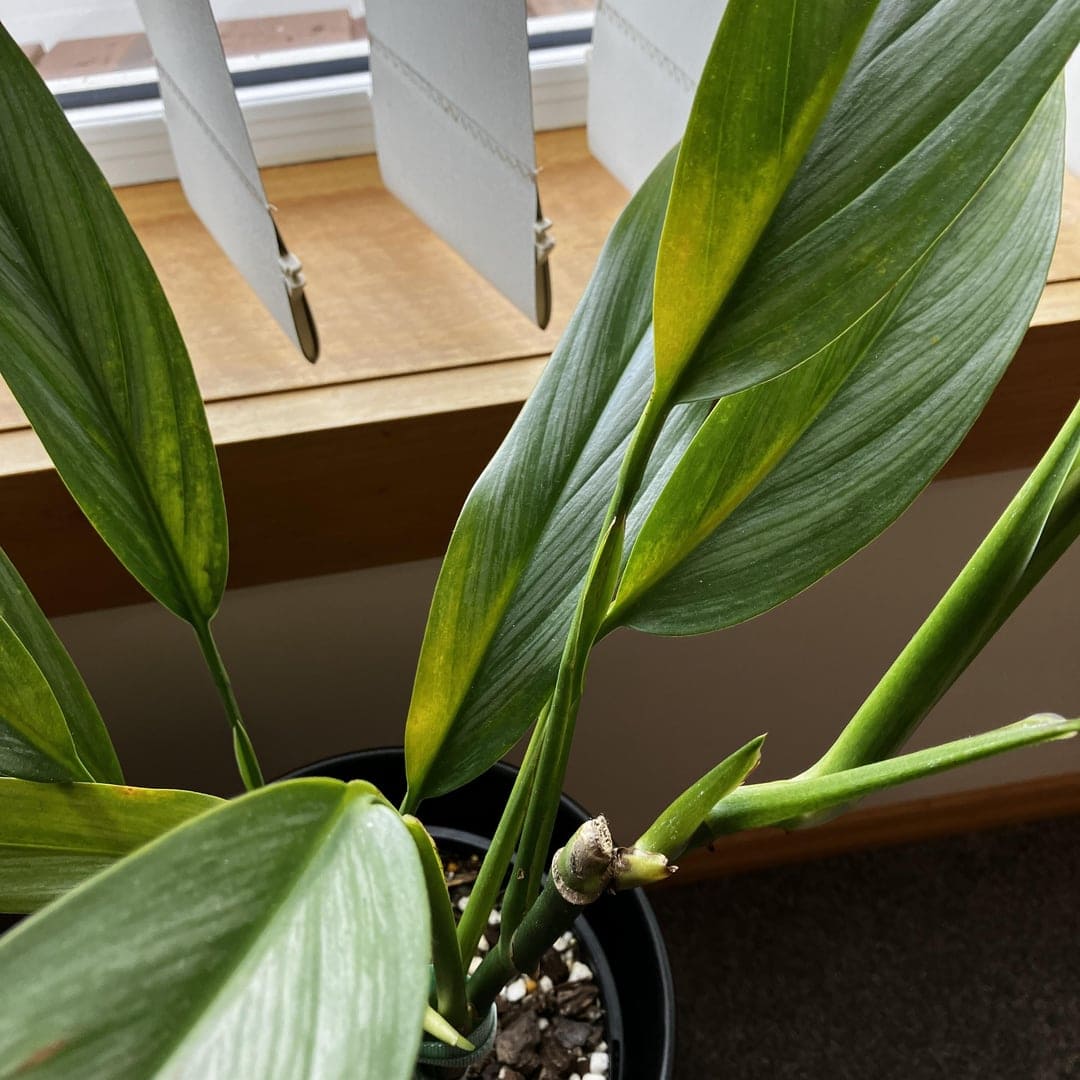
The proper watering technique:
- Check soil moisture by inserting your finger 1-2 inches deep
- Water thoroughly until it runs out the drainage holes
- Allow excess water to drain completely—never let the pot sit in standing water
- Empty saucers or decorative outer pots after 30 minutes
Seasonal watering adjustments:
- Spring/Summer: Typically every 5-7 days as the plant actively grows
- Fall/Winter: Reduce to every 10-14 days as growth slows
- Always prioritize soil feel over calendar schedules
Watch for these watering cues:
- Leaves feel slightly soft or show minor curling when thirsty
- Soil pulls away slightly from the pot edges when dry
- The plant looks a bit droopy (but don’t let it get severely wilted)
- In severe thirst, leaves may droop dramatically and feel limp
Soil: Building the Perfect Foundation
Your Silver Streak isn’t picky about luxury accommodations, but it does have some non-negotiables when it comes to soil. The key concept here is “aeration”—these plants evolved as epiphytes, often growing on other trees rather than in dense earth, so they need soil that allows air to circulate around their roots.
Think of it this way: roots need to “breathe” just like we do. When soil is too dense or stays soggy, roots essentially suffocate, leading to rot and plant death.
My proven soil recipe:
- 2 parts high-quality potting mix (provides nutrients and some moisture retention)
- 1 part orchid bark (adds structure and prevents compaction)
- 1 part perlite or pumice (creates air pockets and improves drainage)
- A handful of activated charcoal (helps prevent bacterial and fungal issues)
Commercial alternatives that work well:
- Aroid-specific potting mixes
- Succulent and cactus soil (surprisingly effective)
- African violet mix amended with extra perlite
Red flags in soil choice:
- Avoid regular garden soil (too heavy and dense)
- Skip potting mixes that contain water-retaining crystals
- Don’t use soil that stays wet for more than a week after watering
Temperature and Humidity: Creating a Tropical Haven
Silver Streaks are tropical souls living in temperate homes, so they appreciate consistent warmth and atmospheric moisture. The ideal temperature range is 65-80°F (18-27°C), with some sources suggesting the sweet spot is 70-80°F for optimal growth.
These plants are surprisingly tolerant of temperature fluctuations, but avoid placing them near:
- Heating vents or radiators
- Air conditioning units
- Drafty windows or doors
- Fireplaces (lesson learned from my own experience!)
While your plant will survive in average household humidity (30-40%), it absolutely transforms when humidity levels reach 50-60% or higher. The difference is remarkable—leaves become more vibrant, growth accelerates, and those silver markings really pop.
Effective humidity boosting methods:
- Humidifier: The most reliable option, especially during dry winter months
- Pebble trays: Place a shallow dish filled with water and pebbles beneath the pot
- Plant grouping: Create a micro-climate by clustering humidity-loving plants together
- Bathroom placement: If you have a bright bathroom, it’s often the perfect humid environment
How to measure humidity: Invest in a simple hygrometer (humidity meter) available for under $10. Place it near your plants to monitor levels throughout the day.
Avoid these humidity mistakes:
- Don’t mist directly onto leaves—this can promote fungal issues
- Don’t place plants on wet saucers without drainage protection
- Don’t rely solely on misting for humidity—it’s too temporary to be effective
Growth Patterns and Styling Your Silver Streak
The Climbing vs. Trailing Decision
One of the most delightful aspects of Silver Streak Pothos is its versatility in styling. You can train it as either a climbing plant or let it cascade gracefully—both approaches showcase different aspects of its beauty.
For climbing enthusiasts: Provide a moss pole, coconut coir pole, or bamboo stake. As the plant climbs, something magical happens—the leaves gradually increase in size and the plant displays its mature characteristics. Those aerial roots will naturally grab onto textured supports, and you can gently guide wayward vines with soft plant ties.
Moss pole setup tips:
- Choose poles at least 2-3 feet tall to accommodate growth
- Keep the moss consistently moist by misting the pole (not the leaves)
- Train vines when they’re young and flexible
- Tie loosely with soft materials to avoid damage
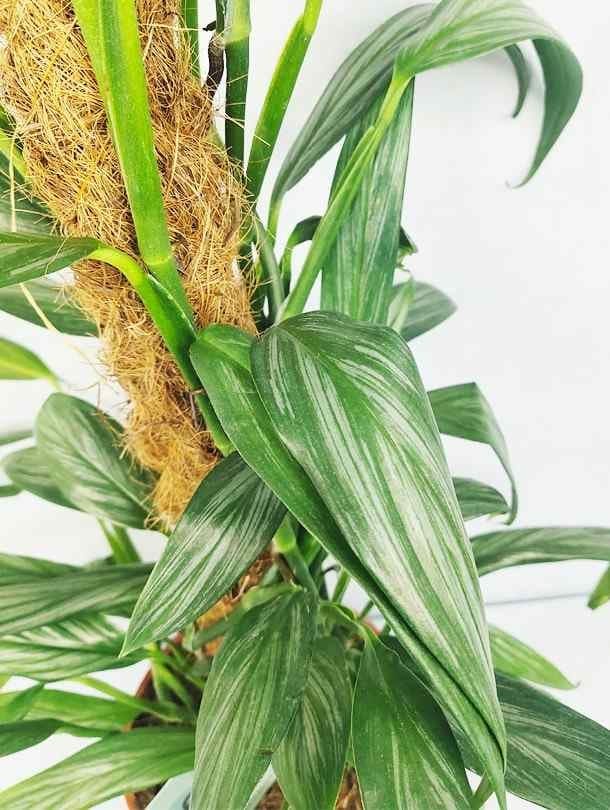
For trailing beauty: Perfect for hanging baskets or tall plant stands, trailing Silver Streaks create stunning cascading curtains. I particularly love how the silver streaks catch light when the vines drape naturally. This method also makes the plant more accessible for regular care and inspection.

Size Expectations and Growth Timeline
Let’s set realistic expectations about what you’re signing up for. Indoors, your Silver Streak will typically reach 6-10 feet in length over several years, with individual leaves growing 8-12 inches long in juvenile form. As plants mature and climb, leaves can reach impressive sizes—sometimes over 18 inches long.
The growth rate is moderate—not the speed demon that Golden Pothos can be, but certainly not a slow poke. During active growing seasons (spring and summer), expect new leaves every 2-4 weeks under optimal conditions.
Growth timeline expectations:
- Months 1-3: Establishment period, minimal new growth
- Months 4-12: 3-4 feet of new vine growth with proper care
- Year 2+: Significant vine development, larger leaf production
- Mature plants (3+ years): Can produce impressive specimen-quality foliage
Juvenile vs. mature characteristics: Young plants display the most dramatic silver markings and smaller, narrower leaves. As plants mature, especially when climbing, the leaves become broader and longer, while silver markings often fade to subtle hints. This isn’t a problem—it’s natural development that brings its own beauty.
Mastering Propagation
Propagating Silver Streak Pothos is one of the most rewarding aspects of ownership. It’s surprisingly straightforward, even for beginners, and there’s something deeply satisfying about creating new plants from your original.
Essential propagation principles: Each cutting needs at least one node (the small bump where leaves emerge and roots develop). These nodes contain all the genetic information needed to create a complete new plant.
Water propagation method (my preferred approach):
- Select your cutting: Choose a healthy vine section 4-6 inches long with 2-3 leaves and at least one visible node
- Make the cut: Use clean, sharp scissors or pruning shears to cut just below a node
- Prepare the cutting: Remove any leaves that would sit below the waterline
- Set up for success: Place in a clean glass jar with room-temperature water
- Provide ideal conditions: Position in bright, indirect light and change water every 3-4 days
- Watch the magic: Roots typically appear within 1-2 weeks and become substantial by 3-4 weeks
- Transition to soil: When roots reach 2-3 inches long, plant in appropriate potting mix
Here’s How to Propagate Plants in Water: Easy Step-by-Step Method
Soil propagation method:
- Prepare the cutting: Same as water method
- Optional hormone treatment: Dip cut end in rooting hormone for faster results
- Plant immediately: Insert into moist, well-draining soil mix
- Create humidity: Cover with a clear plastic bag or place in a propagation box
- Maintain conditions: Keep soil consistently moist but not soggy
- Be patient: Root development takes 3-4 weeks, with new growth indicating success
Pro propagation tips:
- Take multiple cuttings to create fuller plants faster
- Spring and summer offer the best success rates
- Warm conditions (70-75°F) accelerate root development
- Don’t be discouraged if some cuttings fail—it happens to everyone
Troubleshooting Common Challenges
Yellow Leaves: Decoding the Distress Signal
Yellow leaves on a Silver Streak almost always point to watering issues, with overwatering being the most common culprit. The plant essentially waves these yellow flags to communicate distress.
Overwatering indicators:
- Lower leaves turn yellow first
- Yellowing progresses upward if problem continues
- Soil stays wet for extended periods
- Musty or sour smell from soil
The recovery protocol:
- Stop watering immediately
- Check soil drainage and consider repotting if soil stays soggy
- Remove yellowed leaves—they won’t recover
- Inspect roots for black, mushy sections (root rot)
- If root rot is present, trim affected roots and repot in fresh soil
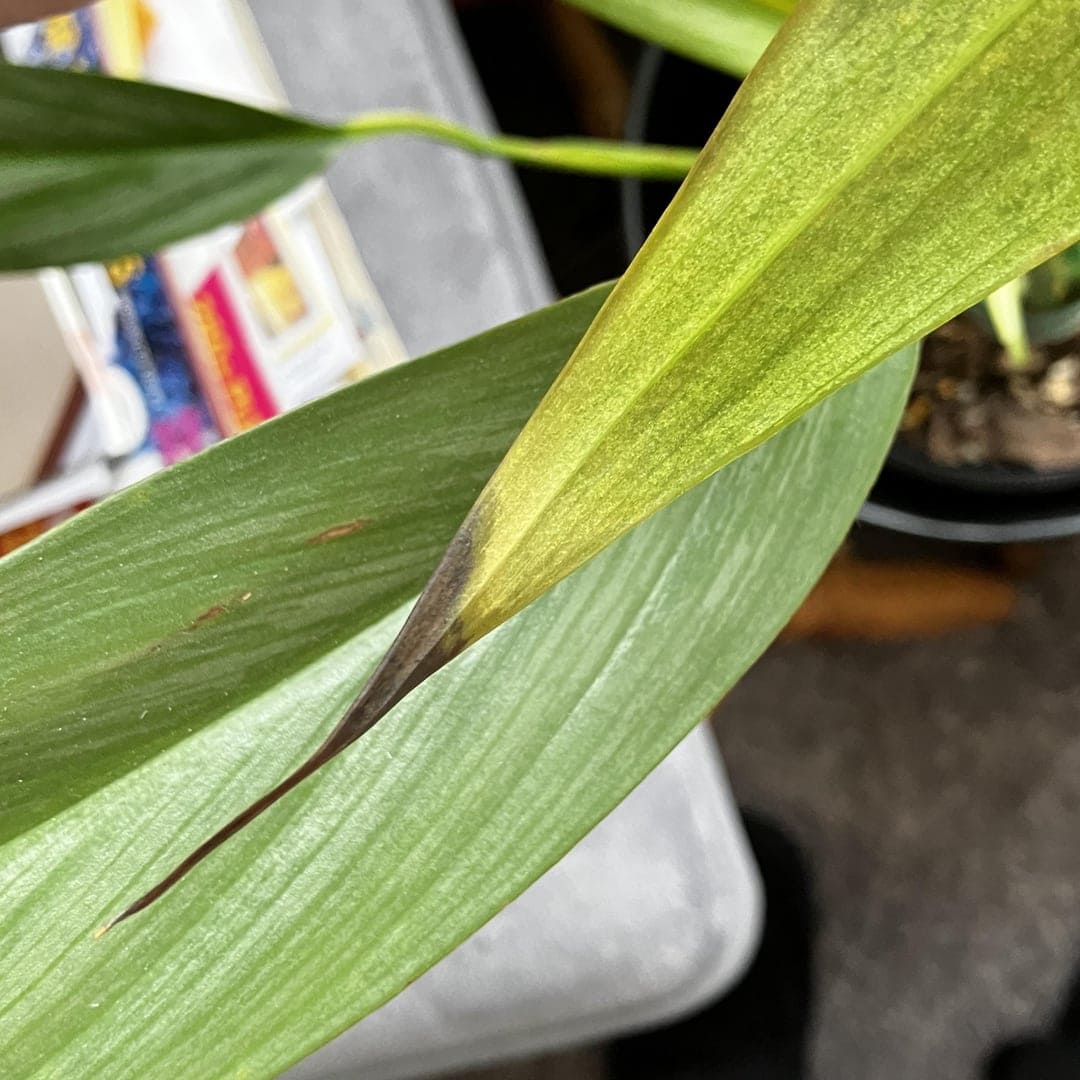
Underwatering yellowing (less common):
- Affects older leaves first but plant appears droopy
- Soil is bone dry
- Leaves feel crispy rather than soft
Find out Why Are My Cucumber Leaves Turning Yellow? Top Causes & Solutions
Leggy, Sparse Growth: The Light Hunger Signal
When your Silver Streak starts producing long stems with sparse leaves and large gaps between nodes, it’s desperately reaching for more light. This stretching behavior, called etiolation, weakens the plant over time.
Immediate fixes:
- Move to a brighter location gradually to avoid shock
- Prune back leggy growth to encourage bushier development
- Provide climbing support to help the plant reach toward light
- Consider supplemental grow lights during dark winter months
Prevention strategies:
- Rotate the plant weekly for even light exposure
- Monitor seasonal light changes and adjust placement accordingly
- Don’t be afraid to move plants around to find their happy spot
Brown Leaf Tips and Edges: Environmental Stress Indicators
Those crispy brown tips and edges are your plant’s way of saying it’s struggling with environmental conditions—usually humidity, water quality, or fertilizer issues.
Common causes and solutions:
- Low humidity: Increase moisture in the air around the plant
- Hard water: Switch to filtered, distilled, or rainwater
- Fertilizer burn: Reduce feeding frequency and always fertilize damp soil
- Inconsistent watering: Establish a more regular moisture schedule
Treatment approach: Trim brown areas with clean scissors, cutting just into healthy tissue. Address the underlying cause to prevent recurrence.
Here’s How to Identify and Fix Brown Spots on Your Snake Plant
Pest Management: Keeping Unwanted Visitors Away
Silver Streaks can occasionally host common houseplant pests. Early detection and swift action prevent minor issues from becoming major problems.
Common pests and identification:
Spider mites: Tiny specks on leaf undersides, fine webbing, stippled leaf damage
- Treatment: Increase humidity, spray with water, use insecticidal soap
Mealybugs: White, cottony clusters in leaf joints and stems
- Treatment: Dab with rubbing alcohol, systemic insecticide for severe cases
Aphids: Small, soft-bodied insects clustering on new growth
- Treatment: Spray off with water, insecticidal soap, introduce beneficial insects
Scale insects: Hard, brown bumps attached to stems and leaves
- Treatment: Scrape off manually, rubbing alcohol, systemic treatment if needed
Comprehensive pest prevention:
- Quarantine new plants for 2-3 weeks before introducing to your collection
- Inspect plants weekly during routine care
- Maintain appropriate humidity levels (pests love dry conditions)
- Keep plants clean by wiping leaves monthly
- Isolate affected plants immediately to prevent spread
Seasonal Care Mastery
Spring and Summer: The Active Growth Period
During warmer months, your Silver Streak shifts into high gear. This is when you’ll see the most dramatic growth and need to adjust your care routine accordingly.
Growth season care adjustments:
- Watering: Increase frequency as the plant uses more water—typically every 5-7 days
- Fertilizing: Monthly feeding with balanced liquid fertilizer diluted to half strength
- Monitoring: Watch for rapid growth and provide climbing support as needed
- Repotting: Best time for repotting if the plant has outgrown its container
- Propagation: Optimal success rates for taking cuttings
Spring awakening signs: Look for new growth appearing after winter dormancy—fresh, bright green shoots and unfurling leaves signal it’s time to resume active care.
Fall and Winter: The Rest and Reflection Period
As daylight hours decrease and temperatures cool, your plant naturally slows down. Fighting this natural rhythm by over-caring can actually stress the plant.
Dormancy period adjustments:
- Reduce watering: Soil takes longer to dry, so extend intervals to every 10-14 days
- Stop fertilizing: Feeding dormant plants can cause fertilizer burn
- Accept slower growth: Don’t worry if the plant seems “stuck”—this is normal
- Monitor pests: Dry indoor air during heating season can increase pest problems
- Maintain humidity: Combat dry indoor air with humidifiers or other moisture sources
Winter care philosophy: Think of this as your plant’s rest period. Just like animals that hibernate, plants need downtime to prepare for vigorous spring growth.
Fertilization: Feeding Your Silver Beauty
Silver Streaks aren’t heavy feeders, and the “less is more” philosophy definitely applies to fertilization. Over-fertilizing causes more problems than under-fertilizing and can lead to weak, leggy growth that’s more susceptible to pests and diseases.
My proven fertilization schedule:
- Spring through early fall: Monthly feeding with balanced liquid fertilizer (10-10-10 or similar) diluted to half the recommended strength
- Winter months: Complete fertilization break
- Application method: Always water the plant first, then apply fertilizer to damp soil
Choosing the right fertilizer: Look for balanced formulations with equal N-P-K ratios. Liquid fertilizers are easier to control and distribute evenly than granular types.
Warning signs of over-fertilization:
- White, crusty buildup on soil surface (salt accumulation)
- Brown leaf tips despite adequate humidity
- Rapid, weak growth that can’t support itself
- Increased susceptibility to pest problems
Recovery from over-fertilization: Flush soil thoroughly with plain water several times to remove excess salts, then resume normal watering without fertilizer for several months.
Understanding When to Repot
Silver Streaks prefer to be slightly pot-bound, so resist the urge to repot annually. These plants actually perform better when their roots have colonized their container, typically requiring repotting only every 2-3 years.
Clear indicators it’s time to repot:
- Roots growing out of drainage holes
- Water runs straight through without being absorbed
- Plant becomes top-heavy and tips over easily
- Growth significantly slows despite optimal care
- Soil breaks down and becomes compacted
The gentle repotting process:
- Choose wisely: Select a pot only 1-2 inches larger in diameter
- Prepare materials: Have fresh soil mix and clean pot ready
- Remove carefully: Gently tease apart any circled roots
- Maintain depth: Plant at the same level as before
- Water thoroughly: Settle soil and eliminate air pockets
- Recovery period: Place in bright, indirect light and monitor closely
Post-repotting expectations: Don’t expect immediate growth—plants often pause for 2-4 weeks after repotting while they establish in their new environment.
Where to Find Your Perfect Silver Streak
The availability of Epipremnum amplissimum has improved dramatically in recent years, though it’s still less common than standard Pothos varieties.
Where to look:
- Local plant shops: Call ahead to check availability
- Online retailers: Etsy, specialized plant sellers, and established nurseries
- Plant swaps and Facebook groups: Often the best prices and variety
- Large retailers: Some big box stores are beginning to carry them
What to expect price-wise: Prices typically range from $15-40 for small plants, with variegated forms commanding premium prices. Size, variegation level, and local availability all influence cost.
Buying tips:
- Look for multiple growth points for fuller plants
- Inspect for pest issues before purchasing
- Ask about the plant’s history and care requirements
- Consider buying from local sellers to reduce shipping stress
Safety First: Pet and Family Considerations
Like all members of the Aroid family, Silver Streak Pothos contains calcium oxalate crystals throughout its tissues. While serious poisoning is rare, ingestion can cause uncomfortable symptoms in both pets and humans.
Symptoms of ingestion:
- Mouth and throat irritation
- Excessive drooling
- Difficulty swallowing
- Vomiting (in severe cases)
- Stomach upset
Prevention strategies:
- Position plants out of reach of curious pets and toddlers
- Consider hanging planters for homes with persistent plant nibblers
- Educate family members about plant safety
- Keep emergency contact information readily available
If ingestion occurs: Rinse the mouth thoroughly with water and contact your veterinarian or poison control center. Most cases resolve without serious complications, but professional guidance provides peace of mind.
Read about Creating a Dog-Friendly Garden: Smart Design Tips for Pet Owners
Styling Your Silver Streak for Maximum Impact
The unique foliage of Silver Streak Pothos makes it a natural showstopper. The key is choosing displays that highlight those gorgeous silver markings while accommodating the plant’s growth habits.
Successful styling approaches:
- Minimalist elegance: A single Silver Streak in a sleek white or black planter, positioned where natural light catches those silver streaks. This approach works beautifully in modern, uncluttered spaces.
- Tropical jungle theme: Group with other aroids like Monstera, Philodendron, and Scindapsus for a lush, layered effect. The Silver Streak’s unique coloring provides beautiful contrast while maintaining the tropical cohesion.
- Bohemian hanging garden: Multiple Silver Streaks at varying heights in macrame hangers create a dreamy, cascading effect. This works especially well in spaces with high ceilings.
- Professional elegance: The sophisticated silver and green coloring makes it perfect for office environments where you want greenery without overwhelming color patterns.
- Container considerations: Choose pots that complement rather than compete with the foliage. Neutral colors—white, black, terra cotta, or natural materials—work best to showcase the plant’s natural beauty.
Frequently Asked Questions
- How fast does Silver Streak Pothos actually grow?
Under optimal conditions, expect 6-12 inches of new vine growth per month during the active growing season. This translates to 3-6 feet of new growth annually, though individual results vary based on light, care, and environmental conditions.
- Why are my silver markings disappearing?
Fading silver markings usually indicate insufficient light. While the plant survives in lower light, those gorgeous silver streaks need bright, indirect light to maintain their intensity. Additionally, natural maturation causes some fading—this is normal as plants age.
- Can I grow Silver Streak outdoors year-round?
In USDA hardiness zones 10-12, yes! For other climates, treat it as a houseplant or bring it outdoors for summer vacation in a shaded spot. Always bring plants inside before temperatures drop below 50°F (10°C).
- What’s the difference between Silver Streak and other Pothos varieties?
The main differences are the elongated, lance-shaped leaves (versus heart-shaped in Golden Pothos), the distinctive silver striations, and the fact that Silver Streak leaves never develop fenestrations like some other Epipremnum species.
Here’s How to Care for Manjula Pothos: Tips for Beginners & Pros
- How do I know if my plant is actually Epipremnum amplissimum?
Authentic Silver Streak Pothos has narrow, elongated leaves with silvery-blue markings, particularly when young. The leaves don’t fenestrate and maintain their lance shape throughout the plant’s life. Be aware that some sellers mislabel other plants, so purchase from reputable sources.
- Is it worth the higher price compared to regular Pothos?
This depends on your personal preferences and budget. If you’re drawn to unique foliage and don’t mind paying more for distinctive plants, absolutely. The care requirements are nearly identical to standard Pothos, so you’re mainly paying for the aesthetic appeal.
Your Silver Streak Success Story Starts Here
Growing Epipremnum amplissimum isn’t just about adding another plant to your collection—it’s about bringing a piece of tropical artistry into your daily life.
Those silver streaks catching morning light, the satisfaction of watching new leaves unfurl with their fresh markings, the pride in successfully propagating your first cutting—these moments transform plant care from a hobby into a genuine passion.
The beauty of Silver Streak Pothos lies in its perfect balance of sophistication and forgiveness. It’s elegant enough to serve as a statement piece in the most discerning plant collections, yet resilient enough for dedicated beginners to achieve success with proper care and attention.
Remember that every plant is an individual with its own personality and preferences. While this guide provides the foundation for success, don’t hesitate to adjust your approach based on what you observe.
Your Silver Streak will communicate its needs through leaf appearance, growth patterns, and overall vigor. Learning to interpret these signals is part of the rewarding journey of plant parenthood.
Whether you choose to let yours trail gracefully from a hanging planter, creating silver-touched cascades, or train it up a moss pole to encourage those impressive mature leaves, you’re embarking on a journey that will bring years of beauty and satisfaction to your home.
The Silver Streak Pothos represents more than just another houseplant—it’s a living work of art that evolves and grows alongside you. As you develop your care routine and watch your plant flourish, you’ll find yourself joining a community of enthusiasts who understand the special magic of these remarkable plants.
Ready to begin your Silver Streak adventure? Trust me, your future self will thank you for taking this step into the wonderful world of Epipremnum amplissimum. Here’s to many years of silver-streaked happiness ahead!
